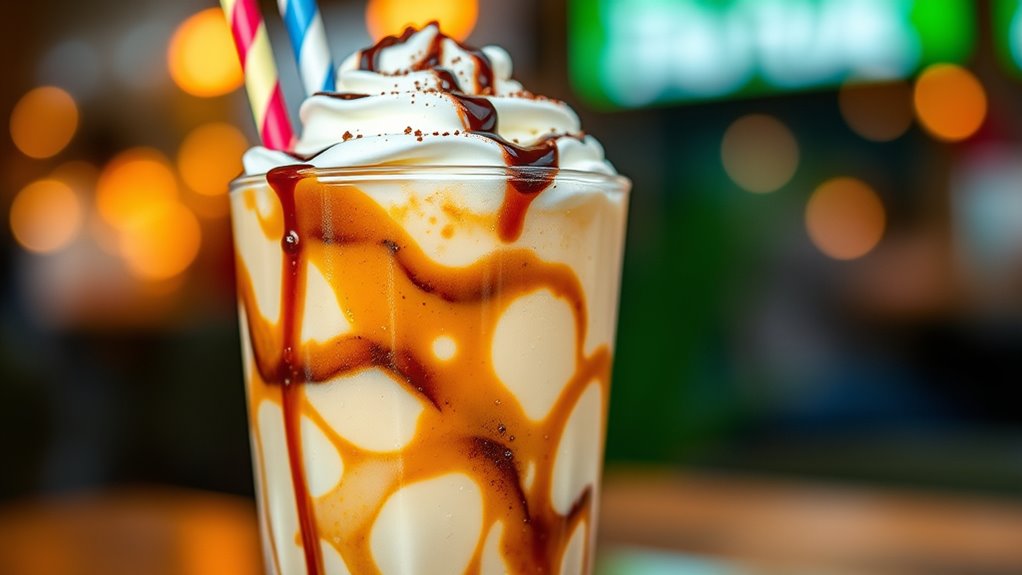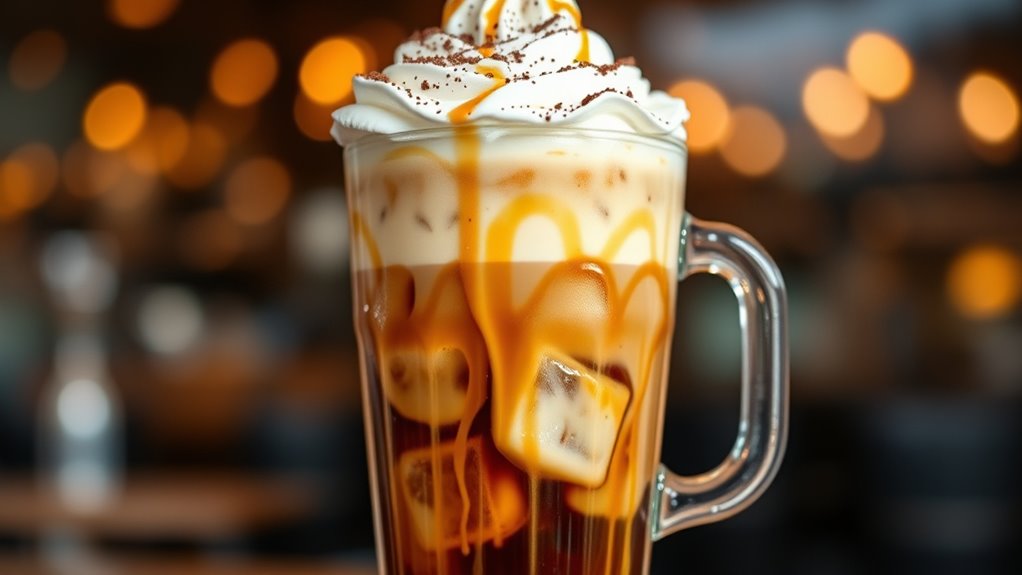Iced coffee trends now include everything from smooth cold brews to sweet, creamy frappuccinos, appealing to a wide range of tastes. Younger consumers favor innovative flavors like salted caramel and international-inspired options, while others value natural ingredients and transparency. Market growth continues as more people enjoy customizable, premium-texture drinks at cafes and home. If you want to explore the latest flavor ideas and innovations shaping this vibrant category, there’s plenty more to discover.
Key Takeaways
- Lighter, nuanced flavors like vanilla and caramel dominate new iced coffee products.
- Cold brew and frappuccinos remain popular, with innovative variations and premium textures.
- International and global-inspired flavors are expanding the flavor profile options.
- Consumers seek transparency, natural ingredients, and wellness-focused additions.
- Younger demographics, especially Gen Z, drive growth through social media trends and customization.

Iced coffee continues to grow in popularity, driven by shifting consumer preferences and innovative product offerings. As a consumer, you’re likely noticing a broader array of flavors, with lighter and more subtle options taking the spotlight. Instead of heavy, overpowering tastes, many prefer nuanced flavors like vanilla, caramel, and coconut, which add indulgence without overwhelming the palate.
Iced coffee is trending with lighter, nuanced flavors like vanilla, caramel, and coconut.
This trend extends globally, with new international flavors and cuisines appearing on menus, giving you the chance to explore unique taste profiles. When choosing iced coffee, ingredient transparency matters; you’re increasingly drawn to products made with real or natural ingredients, aligning with a desire for authenticity and quality.
Premium quality also influences what you buy. You seek indulgence in textures and flavors, whether it’s a rich, creamy frappuccino or a smooth cold brew with a hint of flavor. Interestingly, health considerations aren’t as prominent when it comes to iced coffee, unlike iced tea, which suggests that you’re more focused on flavor and experience rather than health benefits.
This shift supports a market that’s expanding, with a 2% rise in new iced coffee launches across the US and Canada, where the US dominates with 90% of global introductions. Over the past five years, both volume and value are growing steadily—by 6% and 8%, respectively—highlighting increased demand. Per capita consumption is up at a 5% CAGR, showing that more people are enjoying iced coffee regularly.
Younger generations, especially Gen Z, are leading this trend. About 60% of Gen Z adults prefer iced coffee over hot, reflecting a broader shift in preferences among younger consumers. Conversely, older adults—those over 55—still favor hot coffee, with 90% opting for traditional brews.
This demographic divide reveals how preferences are evolving, but it’s clear that the appeal of iced coffee is spreading across age groups, driven largely by younger consumers’ openness to new flavors and experiences.
Product innovation fuels this growth. You’re likely to find a variety of exciting flavors like salted caramel, French vanilla, or exotic options inspired by global cuisines. Many brands are even blending wellness benefits into their drinks, aligning flavor with functional benefits. Single-origin coffees are gaining popularity, offering authentic, distinctive taste experiences.
Moreover, innovative recipes, including spiked iced coffees, are capturing your attention, with about 23% of consumers interested in trying these adult-oriented versions.
Social media amplifies these trends. Conversations around iced coffee have surged by over 30%, making it a hot topic everywhere from social feeds to menus. Over 14% of restaurants now feature iced coffee, especially during summer, thanks to its refreshing appeal.
Its high customization—adding milk, sweeteners, or flavor shots—makes it a versatile choice. Many consumers purchase iced coffee from supermarkets or specialty stores, and nearly a quarter of drinkers enjoy it four to six times a week or more.
Often enjoyed at breakfast, iced coffee’s popularity continues to grow as more people seek convenient, flavorful, and customizable coffee experiences.
Frequently Asked Questions
What Is the History Behind Iced Coffee’s Popularity?
You might wonder how iced coffee became popular. It started with mazagran in 1840 Algeria, then spread to Paris and later the U.S. in the 1920s.
Marketing in the 1960s and the rise of chains like Starbucks in the 1990s boosted its fame.
Today, global trends and innovations like cold brew keep iced coffee a favorite, appealing especially to younger audiences and maintaining year-round popularity.
How Do Different Brewing Methods Affect Iced Coffee Flavor?
Did you know that brewing methods drastically impact iced coffee’s flavor? When you choose hot brewing and then cool, it often results in a bolder, sometimes bitter taste.
Cold brew, steeped for hours, yields a smoother, sweeter profile with more caffeine.
Techniques like Japanese drip or cold drip preserve delicate flavors, while rapid cooling methods can lock in brightness.
Your brewing choice shapes your perfect iced coffee experience.
Are There Health Benefits to Drinking Iced Coffee?
You might wonder if iced coffee offers health benefits. The good news is, it does. Cold brew, a popular iced option, retains antioxidants like chlorogenic acids, which can help reduce inflammation, improve heart health, and lower the risk of neurodegenerative diseases.
Plus, it can boost metabolism and blood sugar regulation. So, enjoying iced coffee can be both invigorating and beneficial for your overall health.
What Are Some Sustainable Practices in Iced Coffee Production?
You can adopt sustainable practices in iced coffee production by sourcing eco-friendly beans that are fair trade and organic, ensuring fair pay and chemical-free cultivation. Use shade-grown coffee and agroforestry practices to protect biodiversity and soil health.
Brew with energy-efficient methods like cold brew kegs, and reduce waste through reusable containers and compostable packaging. Offset your carbon footprint, utilize renewable energy, and conserve water to make your iced coffee more environmentally friendly.
How Can I Customize My Iced Coffee at Home?
Think of your iced coffee as a blank canvas waiting for your personal touch. You can swirl in vanilla syrup for sweetness, sprinkle cinnamon for warmth, or toss in fresh mint for a revitalizing twist.
Freeze coffee into cubes to keep it rich and flavorful, or top it with whipped cream and sprinkles for a decadent finish.
Experiment with dairy or plant-based milks to suit your taste and make it uniquely yours.
Conclusion
As you sip your favorite iced coffee, the cool, velvety splash dances on your taste buds, transporting you to a sunlit café corner. Whether it’s the rich depths of cold brew or the frothy sweetness of a frappuccino, these trends invite you to savor every invigorating moment. So, next time you crave a cool escape, let your imagination swirl with these vibrant flavors and enjoy the perfect chill in every sip.









